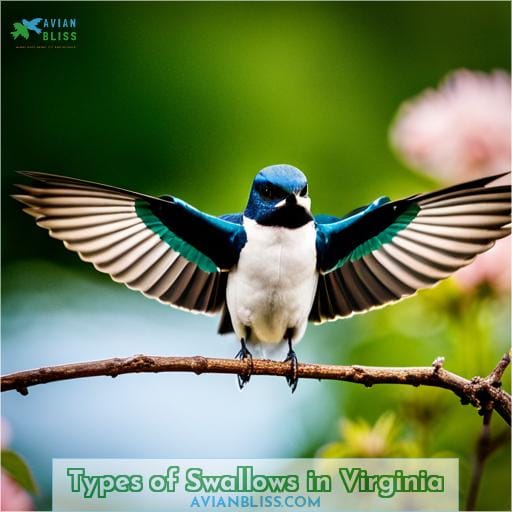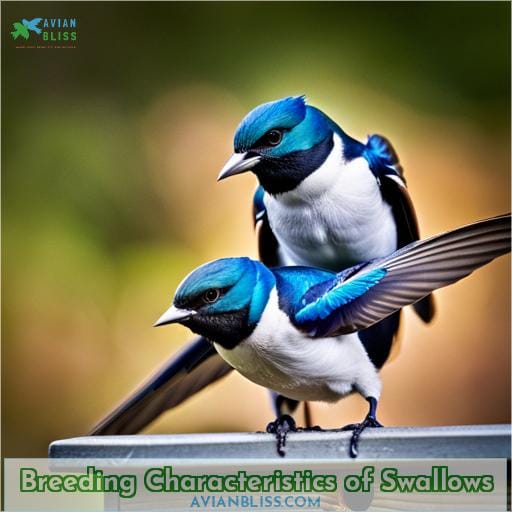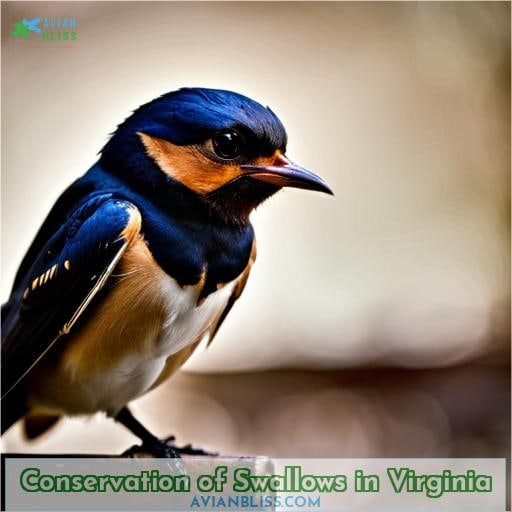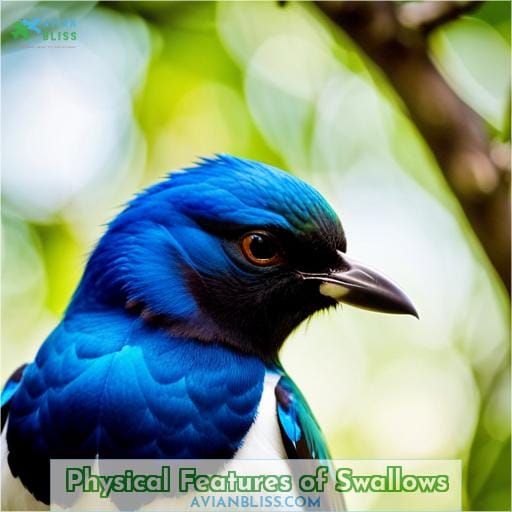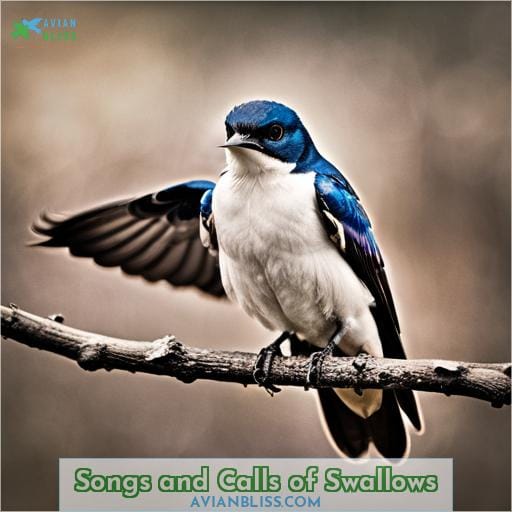This site is supported by our readers. We may earn a commission, at no cost to you, if you purchase through links.
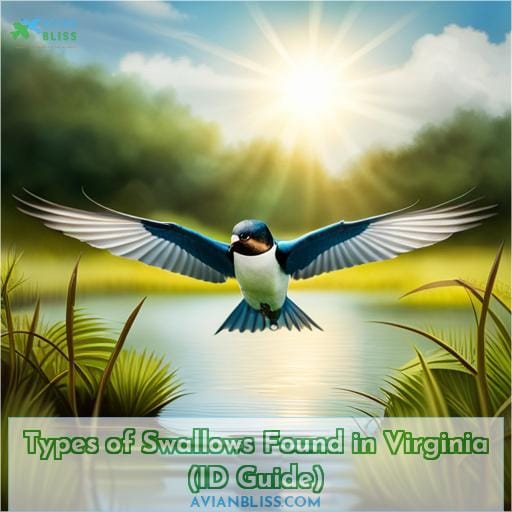 Have you ever been driving across rural Virginia and caught a glimpse of dazzling blue and cinnamon flashes outside your car window? If so, you’ve likely spotted one of the state’s amazing swallow species in flight.
Have you ever been driving across rural Virginia and caught a glimpse of dazzling blue and cinnamon flashes outside your car window? If so, you’ve likely spotted one of the state’s amazing swallow species in flight.
These aerial acrobats skim over fields and glide above lakes as they snag insects, wowing us with their grace and speed.
With up to six types of swallows in Virginia, telling a Tree from a Barn can be tricky for beginning birders. Don’t worry – we’ll break down their key traits so you can ID these beauties next time they dart past.
Table Of Contents
- Key Takeaways
- Types of Swallows in Virginia
- Identification of Swallow Species in Virginia
- Barn Swallow: Blue Upperparts, Orange Underside, Deeply Forked Tail
- Northern Rough-winged Swallow: Light Brown Above, Buff Below, Hunts Over Water
- Purple Martin: Largest, Dark Purplish-blue, Nests in Colonies
- Tree Swallow: Blue-green Above, White Below, Nests Near Water
- Cliff Swallow: Rusty Forehead and Cheeks, White Belly
- Bank Swallow: Light Brown Above, Brown Chest Band, Rare in VA
- Habitat and Behavior of Swallows
- Breeding Characteristics of Swallows
- Conservation of Swallows in Virginia
- Physical Features of Swallows
- Migration Patterns of Swallows
- Songs and Calls of Swallows
- Frequently Asked Questions (FAQs)
- Conclusion
Key Takeaways
- Swallows in Virginia include six species: Barn, Northern Rough-winged, Purple Martin, Tree, Cliff, and Bank.
- Swallows are often seen over open country near water, such as marshes, meadows, and lakes.
- Swallows compete for nesting sites and often use holes and boxes to build their cup nests.
- Swallows face threats such as habitat loss, fewer insects, and nest parasites. Conservation efforts involve providing habitat and nest boxes, as well as protecting wetlands and grasslands.
Types of Swallows in Virginia
Hello there! Virginia is home to six common swallow species that can be identified by their physical features and behaviors: the acrobatic Barn Swallow with its deeply forked tail, the water-loving Northern Rough-winged Swallow, the largest Purple Martin that nests in colonies, the Tree Swallow that nests near water, the Cliff Swallow with its rusty face, and the rather rare Bank Swallow with its brown chest band.
You’ll learn how to identify each species and their unique traits as summer breeding birds in the diverse habitats of the state.
Barn Swallow
You’d spot that deeply forked blue tail a mile off as the feisty fella darts across the marsh, gobbling up bugs for his chicks back in the nest. Competing for prime nest sites, this aerial insectivore’s adaptations help it snatch midges mid-flight.
Its feather-lined mud cup keeps eggs cozy. Come fall, barn swallows flock south in droves, their streamlined silhouette zipping gracefully through the sky.
Northern Rough-winged Swallow
Seeing the brown-backed swallow skimming insects above the still pond, you realize it’s the northern rough-wing in its breezy habitat. Foraging above wetlands, this adept flyer snatches aerial insects with rapid wingbeats.
Adapting from the breeding grounds up north, it now frequents the open marshes and ponds. As conservation efforts provide more wetland habitats, you may spot more of these brown bellies hunting the skies.
Purple Martin
Hear those boisterous chirps echoing across the colony as the largest of them all swoops down, its dark feathers glinting purple and blue in the sunlight. The swooping marathon brings beakfuls of bugs back home. Though populations face threats like habitat loss and climate change, you can help by putting up houses near wetlands, preserving ancient migration routes, and keeping watch for new diseases.
Tree Swallow
You’re elated to peck that wonky blue-green bird who lives where you can peck bugs over water in VA. The male arrives early, displaying his forked tail to attract a mate for nesting in a hole in a live tree near lakes.
Hunting aerial insects in hovering flights over water, this bird is one of the first spring migrants, laying its pale eggs after pairing off.
Cliff Swallow
Look at that rusty forehead and those white bellies – must be those cliff swallows nesting in the colonies again! Those cliff swallows sure move quickly, weaving and bobbing, collecting bugs for their hungry chicks.
Their mud nests, plastered to cliffs and under eaves, provide shelter, but come fall they’ll flock south, abandoning their crumbling homes.
Bank Swallow
Dig deeper and you’ll uncover that the rare Bank Swallow in Virginia builds tunnel nests in sandy banks near slow-moving streams, cleverly carving cozy cavities to cradle a new generation.
- Feeds on insects caught in flight over water
- Nests in colonies in steep, eroded banks
- Arrives in April from South America
Rare in the state, this species is declining as development alters the sandy nest banks it requires. Conserving natural shorelines and reproducing vertical sand banks will give Bank Swallows the specialized habitat they need to thrive.
Identification of Swallow Species in Virginia
There are six main species of swallows found in Virginia, each with distinctive identification features. Look for the Barn Swallow with its blue upperparts, orange underside, and deeply forked tail. The Northern Rough-winged has light brown upperparts, a buff underside, and hunts over water.
The largest is the Purple Martin with its dark purplish-blue color and nesting in colonies. The Tree Swallow has blue-green upperparts, a white underside, and nests near water. The Cliff Swallow can be identified by its rusty forehead and cheeks and white belly, while the Bank Swallow is light brown above with a brown chest band and is rare in Virginia.
Barn Swallow: Blue Upperparts, Orange Underside, Deeply Forked Tail
Of the swallows in Virginia, the barn swallow is the one with blue upperparts, an orange underside, and a deeply forked tail. As a summer visitor, its blue back and orange throat make it instantly recognizable over fields and along rivers where it hunts insects on the wing and forms social, colony-dwelling bands.
Returning north in spring, it constructs mud nests under eaves, its distinctive forked tail regularly fanning as it comes and goes from the bustling colony site.
Northern Rough-winged Swallow: Light Brown Above, Buff Below, Hunts Over Water
You’ll spot a light brown bird skimming the water’s surface as it snatches insects while cruising over the lake.
- Glides low over water
- Snatches insects in flight
- Nests in holes in banks near water
The northern rough-winged swallow hunts over ponds, rivers, and lakes, feeding on aerial insects. With buff underparts and brown upperparts, it breeds near water, competing for nest sites. Specializing in low, swooping flight, it thrives near wetlands across North America.
Purple Martin: Largest, Dark Purplish-blue, Nests in Colonies
You can spot the largest swallow in Virginia, the dark purplish-blue Purple Martin, nesting in noisy colonies. Often forming large colonies in open areas near water, Purple Martins arrive early in spring to establish breeding sites.
Competing for nest cavities and mates, males display to attract females. Both parents care for the young, sharing food gathered over water. Among the earliest northbound migrants, Purple Martins form new pair bonds each year.
| Species | Colony Size | Nest Site |
|---|---|---|
| Purple Martin | Large, 100+ pairs | Cavities in dead trees or nest boxes |
| Cliff Swallow | Small, up to 2000 pairs | Mud nests on cliffs |
| Bank Swallow | Small, up to 300 pairs | Burrows in earthen banks |
| Barn Swallow | Solitary pairs | Mud cups on rafters |
Tree Swallow: Blue-green Above, White Below, Nests Near Water
You’d recognize a tree swallow by its blue-green upperparts and white underside as it nests near bodies of water. Yet wetland destruction and rural land development deplete the tree canopy and aquatic insects they rely on.
These aerial acrobats snatch flying insects and occasionally eat vegetable material. They need tree holes and nest boxes to raise young, but contaminants can bioaccumulate, so we must conserve wetlands to support these birds and the web of life sustained by water.
Cliff Swallow: Rusty Forehead and Cheeks, White Belly
With a rusty forehead and cheeks contrasting its white belly, this swallow’s distinct face makes it easily identifiable among Virginia’s airborne species.
In cliff swallows, identification features include:
- Rusty orange forehead and throat feathers
- White underside from chin to tail
- Dark blue-black back and wings
Nesting in cliffside crevices and under bridges, this species thrives near water yet struggles where rock faces are scarce. Despite insect decline, flocks continue to travel annually between South American wintering grounds and summer breeding sites in the Old Dominion.
Bank Swallow: Light Brown Above, Brown Chest Band, Rare in VA
Y’all should take care when searching for bank swallows in Virginia since they are rare in the state. As you explore the marshes where these light brown-backed, white-bellied birds nest in holes along earthen banks, listen for their sharp vit-vit calls.
While competing for nest sites, the swallows burrow tunnels into vertical banks near water to build feather-lined nest cups for raising broods on insects caught on the wing. Despite state programs at local centers, habitat loss causes declines among these famous long-distance travelers.
Habitat and Behavior of Swallows
You often see swallows over open country near water, such as marshes, meadows, and lakes. They nest in holes and boxes, competing for the best sites. These birds are migratory summer breeders that flock south starting in July, feeding on aerial insects when they arrive and also dining on berries or catching bugs on the ground when it’s cold.
Habitat: Open Country Near Water, Marshes, Meadows, Lakes
Soaking up the sun, you find those quick-flittering feathered friends skimming the marshes and dive-bombing bugs over the lake.
- Nest in holes and cavities
- Feed aerially over water
- Flock in open country
The swallows thrive in open habitats near water, flocking over marshes, meadows, and lakes to catch insects on the wing. Despite dwindling nest sites and declining breeding success from increasing pesticides, these aerial acrobats continue gracing our skies with their buoyant flight.
Nesting Habits: Holes, Boxes, Competition for Sites
You’re scrambling for prime real estate as soon as you arrive.
| Challenges | Advantages |
|---|---|
| Competition for Sites | Protection from Predators |
| Limited Holes and Cavities | Stable Temperature Regulation |
| Fighting Over Locations | Convenient Feeding Access |
The swallow’s nesting habits revolve around holes and boxes, which provide shelter but also lead to fierce competition. Although bickering over prime real estate is tiring, the payoff is a safe nesting spot to raise young.
For returning migrants, these cavities are heavenly camper cabins offering cozy refuge.
Migratory Behavior: Summer Breeders, Flock Migration
After the weather cools, you see vees of small birds streaming south across a vivid blue sky, their wings beating fast against the wind. Migrating in flocks from summer breeding grounds, swallows display amazing stamina, soaring on warm thermals and feeding on insects along the way.
Their seasonal movement connects distant nesting and wintering habitats across continents. United in purpose, they fly far but return each spring to familiar sites with nesting materials gathered on previous journeys, beginning the migratory cycle anew.
Feeding Habits: Aerial Insects, Berries, Ground Feeding
Feast on hasty bites of flying bugs, then peck at berries when cold shrinks the clouds of insects above open fields and waters.
- Capture mosquitoes and midges over ponds.
- Pluck ripe fruit from bushes and trees.
- Peck spilled grain from freshly cut fields.
As temperatures drop, insects disappear, so swallows adapt by eating more berries and seeds. They even forage on the ground, finding sustenance wherever they can before migrating south. Though their diet changes with the seasons, swallows remain exquisitely designed for snatching insects from the air.
Breeding Characteristics of Swallows
Greetings, bird watcher! As swallows establish breeding territories, you’ll find their artful nests tucked into tree cavities and eaves. The female lays 4-7 eggs and incubates while both parents tend to the hatchlings until they fledge 18-22 days later.
Nest Construction: Cups of Grass, Weeds in Cavities Lined With Feathers
Sounds like you’ve got yourself a cozy little nest in that chimney. Those swallow parents work hard gathering soft grasses and lining the nest with their own feathers to keep the eggs warm. It’s incredible watching them fly back and forth, carrying material to expertly build the nest cavity.
Their construction know-how allows the chicks to hatch in a protected microclimate. Bob McGuire would be proud of their handiwork. Common swallows use their excavation techniques and knowledge of grass fiber properties to create the perfect breeding sites.
Egg Laying and Incubation: 4-7 Pale Eggs, Female Incubates
You’re peering into a swallow’s nest and glimpsing 4-7 pale eggs as mama bird keeps them cozy. She gently turns those eggs, providing warmth so the chicks develop properly. The eggs’ coloring helps camouflage them in the nest.
But soon enough, the hatchlings are going to join the colony, learning to fly and hunt. We have to help protect swallows’ habitats so future generations can witness nature’s miracles.
Parental Care and Fledging: Both Parents Feed Young, Fledge in 18-22 Days
You’ll watch the parents take turns feeding the gaping young as they grow feathers and strengthen wings, ready to leave the nest in just 3 short weeks.
- The male and female both feed nestlings.
- They bring insects, berries, seeds – whatever they can find.
- The diet changes as the chicks grow.
- Fledglings make their first flights at 18-22 days old.
- After leaving, the young stay near the nest site.
The devoted parents tend the chicks until they fledge and gain independence. Their tireless care ensures the next generation thrives.
Conservation of Swallows in Virginia
Swallows are facing several threats that impact their populations in Virginia. You can help swallows by putting up nest boxes and supporting the conservation of wetlands and grasslands where they feed and breed.
Threats to Swallow Populations: Habitat Loss, Declining Insects, Nest Parasites
You’ve seen firsthand how wetland draining and overdevelopment threaten the homes of these aerial acrobats. Pesticide exposure weakens their immunity. Artificial lights disrupt migrations. Introduced species ransack nests. Migratory stopover sites are disappearing, so providing habitat and nest boxes helps offset the damage we’ve caused.
Conservation Efforts: Providing Nest Sites, Conserving Wetlands and Grasslands
Folks, if you want to save them birds, we gotta go big – build nesting skyscrapers, flood the countryside, let the grass grow wild! Increasing insect populations and controlling nest parasites will help our feathered friends.
Planting native grasses, monitoring water quality, and restoring wetland habitats provide ideal nesting grounds.
Physical Features of Swallows
Let’s take a closer look at some key physical features of swallows in Virginia. With their sparrow-sized, 5 to 7-inch bodies weighing just half an ounce, you’ll recognize the cone shape, flat head, and broad shoulders typical of these aerial acrobats.
Watch for the forked tail and steel-blue back, but don’t miss the cinnamon-brown forehead and throat or pale buff underside as these swallows perform their graceful, buoyant flight over wetlands and fields.
Size: Sparrow-sized, 5.9-7.5 Inches Long, 0.6-0.7 Ounces
Y’all are looking at little birds about the size of sparrows!
- Their bodies are cone-shaped.
- Their wings beat rapidly and gracefully.
- They sing liquid twitters when flocking together.
These sparrow-sized swallows build cup nests with grass, weeds, and feathers in tree holes and under eaves.
Shape: Cone-shaped Body, Flat Head, Broad Shoulders, Forked Tail
Swallows sport a cone-shaped body, flat head, broad shoulders, and a deeply forked tail that let them make those signature aerial maneuvers. Early in the morning, they take flight and land in the fog, scouting prime nest locations in holes where sunlight will warm them.
You’ll spot them perching on cattails near water, prepping for another graceful spiraling ascent.
Coloration: Steel Blue Back, Cinnamon-brown Forehead/throat, Pale Buff Underside
You’ll notice their steel blue backs and cinnamon-brown foreheads and throats against the pale buff of their undersides. As you observe the swallows in flight, the contrast of colors reveals itself – the sheen of the steel blue feathers above, the rusty cinnamon hues on the face, all set against the soft buff belly.
These varied hues connect and blend into a whole, revealing nature’s artistry at work in their plumage.
Flight Characteristics: Buoyant, Graceful, Rapid Wingbeats and Glides
You’d notice their buoyant, graceful flight with rapid wingbeats and glides over the fields. Watching them soar through clouds, dance along the water’s surface, and dip down to peck insects, you’d admire their aerial agility.
Their maneuverability enables them to nimbly catch prey, exhibiting mastery of the skies as they bank and dive with ease.
Migration Patterns of Swallows
The familiar swallow species you see gathering by the thousands over Virginia’s ponds and fields in summer makes a long journey every year. From July through fall, these acrobatic aerialists flock south, returning in early spring to scout out nest cavities in trees, under bridges, or in man-made nest boxes across the state.
Seasonal Migration: Flock Migration in July-fall South, Early Spring North
You’re heartened to see the sky fill with their buoyant forms each spring, signaling warmer days ahead. Taking wing in vast flocks, the swallows migrate south in July through fall, stopping at wetlands and fields to rest and feed during their long journey, before returning north again in early spring.
Their communal flocking behavior and precise navigation fascinate researchers who monitor band returns, track migration routes, and study the social hierarchies of breeding colonies.
Use of Nest Boxes and Natural Cavities During Migration
During migration, you nab the best nest boxes and tree hollows to rest those weary wings in between lengthy sojourns. You scout for good locations as you journey south or north, vying with other swallows for prime real estate to fuel up on insects and shelter from storms.
- Easy access to flying insects.
- Protection from rain and wind.
- Enough room for rest.
- Nearby water sources.
- Defensible from competing species.
Through competition and cooperation, swallows find just what they need to continue their epic migrations across continents.
Songs and Calls of Swallows
Swallows communicate with each other through liquid twitters and melodic calls. The males sing courtship songs to attract females during the breeding season, using distinctive vocalizations to defend nest sites and attract mates.
Description of Swallow Songs: Liquid Twitters
You’ll hear liquid twitters as they chatter near water.
| Species | Male Song | Female Song |
|---|---|---|
| Barn Swallow | expressive twitters | raspy chits |
| Northern Rough-winged | rolling chatter | mechanical twitters |
| Purple Martin | gurgles and chortles | soft queeks |
Their vocalizations reflect flocking behavior, insect diet, extended families, and predator avoidance.
Significance of Songs in Court
Hear males whistling sweetly to entice females to their nest sites.
- Vocalizations help establish breeding territories.
- Complex songs strengthen pair bonds between mates.
- Coordinated calls aid in foraging and defending young.
Their liquid twitters vocalize breeding readiness. Melodic trills stake claims to prime nesting spots. Harmonized duets cement lifelong pair bonds. Synchronized chirps scout food sources efficiently.
Frequently Asked Questions (FAQs)
When do swallows first arrive in Virginia each year?
You glimpse the first swallows skimming over sun-warmed meadows in March. The early arrivals twirl and swoop, scouting nest sites amid fluttering courtship displays. As spring’s longer days coax insects aloft, more swallows flock in, plunging and darting in aerial ballets.
By April, barn swallow pairs inspect last year’s mud nests under eaves, while tree swallows seek holes in dead trees near water.
How many broods do swallows typically raise in a season?
Most swallows raise two broods per breeding season. After successfully fledging their first brood, the pair will quickly construct a new nest and lay another clutch of eggs. The female incubates the eggs while the male provides food. With both parents caring for the young, the second brood is usually fledged by late summer before fall migration.
What is the lifespan of most swallow species?
Generally, the lifespan of most swallow species is 2 to 3 years. However, some individuals have been known to reach ages of 5 to 7 years if they can avoid predators and survive migration. Their lives are fleeting, yet elegant as they dart and soar through the skies, feeding on insects.
Though fragile, they find strength in numbers, competing en masse for nesting sites and weathering storms together during migration. For their brief lives, they grace the summer skies, bringing color and vitality before heading south again come fall.
How can I attract swallows to nest on my property?
Put up nest boxes designed for their species near water and open fields. They prefer areas with mud to build nests and plenty of insects to eat. Give them space by not disturbing nests once they move in. They’ll return yearly if conditions stay ideal.
Are any swallow species in Virginia endangered or threatened?
You’re in luck! None of Virginia’s common swallow species are currently endangered or threatened. These aerial acrobats dart through the summer skies, snatching insects, with their forked tails streaming behind like kites on windy days.
Conclusion
Through watchful eyes, you’ve spotted their forked tails. Vibrant splashes of color glide across open skies, diving and rising with the winds. During summer’s warm embrace, swallow songs fill the fields and forests. Before the chill air beckons south, take care to provide habitats where generations yet unborn will learn the twitters of spring.
Though swallows in Virginia may wander far, these harbingers of summer always find their way home.

